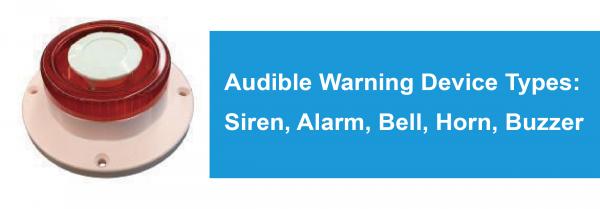Audible Warning Device Types & Differences: Siren, Alarm, Bell, Horn, Buzzer

In various environments, audible warning devices are essential for ensuring safety and alerting individuals to critical situations or potential dangers. These devices and equipment come in several types, each designed to fulfill specific roles and functions. Understanding the differences between sirens, bells, alarms, horns and buzzers can help you choose the right audible warning system catering to your needs.
1. Sirens
Sirens are perhaps the most powerful of audible warning devices. They are designed to generate a loud, attention-grabbing sound that can travel long distances. Sirens are often used in emergency situations such as fire alarms, burglary system, protection system, tornado warnings, or other critical alerts. The sound produced by a siren typically varies in pitch and volume, which helps to capture attention even in noisy environments. Modern sirens can be found in both stationary installations (like those on fire trucks) and portable models.
Key Features:
- High decibel sound output
- Variable Frequency, pitch and volume
- Effective over long distances
2. Alarms
Alarms are versatile devices used in both residential and commercial settings. They serve a variety of functions, including security alerts, fire warnings, and system notifications. Alarms can be configured to produce a range of sounds, from a warble tone to intermittent beeping pattern, depending on the urgency of the alert. Most modern alarms integrate with other security & safety systems, such as infrared detector or smoke detector, to provide comprehensive protection.
Key Features:
- Customizable sound tone pattern
- Easy integration into systems
- Suitable for various applications
3. Bells
Bells have a distinctive, melodious sound that is less harsh than sirens or alarms. They are often used in offices, schools and religious buildings to signal the start or end of classes & meetings or events. Bells are also used in some commercial & industrial settings to indicate shift changes or other scheduled activities. While bells are not as loud as sirens, typically in the range of 90-105 dB/m, their clear and recognizable sound makes them effective for their intended purposes.
Key Features:
- Resonant & pleasant sound tone
- Lower decibel volume compared to sirens
- Ideal for scheduled notification
4. Horns
Horns are another type known for their loud, penetrating sound, which is effective in noisy environments. They are commonly used in vehicles such as trucks and trains to warn pedestrians and other drivers. Industrial horns are also used in factories and warehouses to signal shifts, break times, or emergency situations. Unlike sirens, which often produce a wailing sound, horns emit a more consistent, steady & deep bass tone.
Key Features:
- Loud and clear sound
- Useful in noisy environments
- Consistent & steady tone
5. Buzzers
Buzzers are characterized by their short, sharp, and repetitive sounds. They are typically used in situations where a quick notification alert is required, such as in doorbells, timers shows, or device/equipment alert. Buzzers commonly have continuous or intermittent sound tone. Due to their distinct and repetitive sound, buzzers are effective for alert in close proximity of under 5 meter distance.
Key Features:
- Sharp, repetitive sound
- Suitable for close-range notification & warning
- Common in timers, appliances and devices
Choosing the Right Audible Warning Device
When selecting an audible warning device, consider the environment and the specific needs of the situation. Sirens are suitable for emergency requiring immediate & maximum attention, while alarms offer flexibility for various safety and security applications. Bells are best for routine notifications and scheduled alerts, horns are ideal for high ambient noise environments, and buzzers excel in close-range signaling.
By understanding the characteristics of each type of audible warning device and its appropriate applications, you can make informed decisions that enhances communication and safety in your environment.
For more detailed information on audible warning devices and their applications, please contact our specialists at Key Security for more information.

